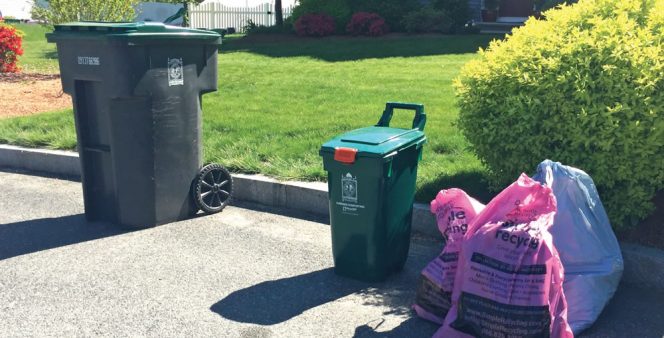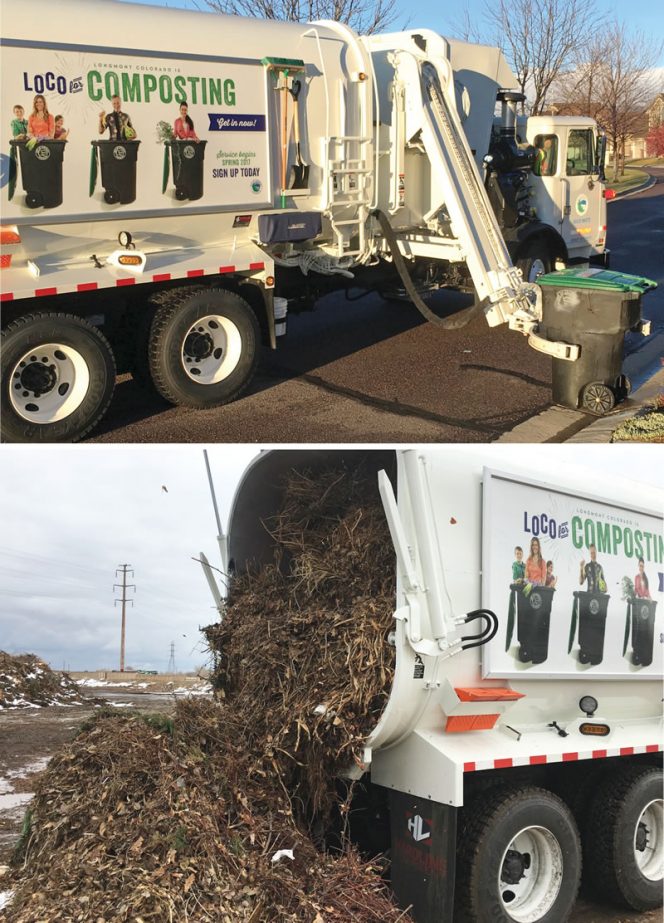Focus on two communities that utilize Pay-As-You-Throw unit-based pricing to reduce disposal and increase materials and organics recycling.
Marsha W. Johnston
BioCycle October 2018

Residents purchase 13- or 33-gallon blue trash bags (blue bag behind pink bag for reusable item donation). Natick is just completing a curbside food waste collection pilot where 500 households were give 13-gallon carts.
In March 2002 (FY 2003), Natick was facing cuts to local aid and rising disposal costs, which resulted in a $1.5-million hole in its budget. The Board of Selectmen instituted a one-time, $150 fee per household to address the shortfall and set up a 14-member PAYT Committee to study unit-based pricing as a long-term solution. The committee included representation from the Town’s Recycling and Finance committees, Sanitation Division and the Board of Selectmen. It met biweekly, led the PAYT analysis and had subcommittees for key issues, such as pricing and outreach.
The one-time trash fee covered the $1.5-million budget gap, but did not reduce trash volumes or increase recycling. As a result, the PAYT Committee recommended that Natick move forward with PAYT, pricing it such that it would cover the continuing shortfalls caused by state cuts to localities, and rising costs. The committee became a champion for PAYT public outreach and education, notes Jillian Wilson-Martin, the Town’s Sustainability Coordinator. In the spring of 2003, Natick did a lot of direct mail, funded substantially by the Massachusetts Department of Environmental Protection (MassDEP).
The PAYT program was launched in July 2003 (FY04) with two bag sizes — 15- and 33-gallon, which were sold at retail stores for $1 and $1.75 each, respectively. Natick’s disposal costs declined, its six trucks switched from 5- to 4-day collection, recycling was collected every other week, and bulk pick up was done on Mondays instead of Saturdays, cutting overtime costs.
“It was going pretty smoothly,” says Wilson-Martin, “until we got political backlash from a group of residents who disrupted meetings. It was an isolated resistance led by a small percentage of the population; there was no widespread discontent. Overall, people understood why [PAYT] happened because the committee had been so effective.” The opposition’s anger over PAYT fees was effective, and it obtained enough signatures to hold a special election on a referendum to overturn PAYT.
The town had six weeks to prepare for the special election, which was held in December 2003. The opponents’ argument against PAYT was countered by information from the “Natick Saves” Ballot Committee on how much money the town had saved. The result: A record-high voter turnout, with 72 percent of voters in favor of keeping the program.
Program Developments
To further reduce waste disposal, the town of Natick began a residential curbside food waste and food-soiled paper collection pilot several years ago. The pilot has been servicing 500 households. All food waste is included. Residents received a 13-gallon food waste curbside cart, along with compostable BioBags. Starting in November, Natick has arranged for Black Earth Compost in Gloucester (MA) to offer a subscription collection service to all residents, utilizing a 13-gallon food waste cart.
To reduce overall trash volumes, the town of Natick is considering offering an even smaller-sized trash bag. “We were already talking about a smaller bag, and the waste audit shows that people are putting out, on average, one bag per week,” says Marsette. Smaller bags combined with the town’s expanded food waste collection program in November could further reduce volumes.
New challenges for trash and recycling have emerged in Natick due to China’s import ban on recycled materials, which is causing recycling costs to skyrocket. Natick just completed a waste audit to help figure out how to address the situation. “New budget pressures [because of recycling markets] are something to consider in terms of how the [PAYT] program works,” he adds. “It’s a really big problem, and no one has cracked the nut. We’re hopeful the private sector will take advantage of the changing market to innovate and this short term challenge will result in a better recycling stream long term.”

Longmont residents who sign up for curbside compostables collection receive a 96-gallon cart with a green lid imprinted with program guidelines. The city purchased a 28-yard automated side-loading organics collection truck to service the program (top). Organics are unloaded at a transfer station (bottom) and taken to A-1 Organics for composting.
New Launch In Longmont
Residents’ desire to divert source separated organics spurred the city of Longmont, Colorado to establish a Pay-As-You-Throw (PAYT) program in 2017, according to Charles Kamenides, Longmont’s waste services manager. At the same time, a regional landfill just north of Longmont announced it would be closing and was expected to reach maximum capacity in 2025. “We had some community groups, such as Sustainable Resilient Longmont, that started coming to council meetings, maybe late 2015, early 2016, asking for a curbside compostables collection program,” Kamenides explains. “It got to the point where the council and mayor directed staff to study the options and costs to provide it.”
The city of Longmont hired Skumatz Economic Research Associates to conduct a field study of 400 households’ waste containers over a cross-section of residential areas. The study was not a detailed waste audit, rather a “cursory examination to see how full the trash and recycling containers were and how much organics and recyclables were still in the trash containers,” he notes.
The study found that not only did the trash bins contain a lot of organic waste, but 70 percent of residents were using only three-quarters of their container’s total volume. “They were over-subscribed, and could do with smaller containers,” Kamenides says. At that time, 79 percent of Longmont residents used 96-gallon bins, in part because they cost only $4/month more than the 48-gallon bins.
As a result of the study, and in line with its Sustainability Plan goal of increasing landfill waste diversion to 50 percent by 2025, the Longmont City Council directed Kamenides to implement a curbside compostables collection service and PAYT program simultaneously. “The PAYT program evolved around starting the composting program,” he explains. City Council decided to price the larger bins higher and added a less expensive Every Other Week (EOW) 48-gallon container as well. The rate for the 96-gallon bin was almost doubled.
Composting Service
In preparation for its service that would collect food waste, yard trimmings and food-soiled paper, the Waste Services Division bought a new 28-yard, automated side-loading organics collection truck (Autocar chassis, Amrep body). To save money on the new carts it would need for the EOW and compostables collection services, the Division replaced bin lids with lids of different colors (representing each stream) rather than buy all new carts.
The new PAYT variable pricing and curbside compostables programs were launched in April 2017. Every single household unit up to 8 units is compelled by code to use the city sanitation service with its PAYT rates. The composting service, however, is voluntary. When residents sign up at a cost of $6.60/month for EOW service, they receive a 96-gallon cart with a green lid that is imprinted with program guidelines.
In just over a year, 4,700 customers have signed up for organics collection, and 2,700 customers for EOW trash collection. The city of Longmont’s rate of waste production is now 2.6 lbs/capita/day, down from 2.7 in 2017. Its goal is less than 2.0 lbs/capita/day. The Longmont sanitation division is trucking an average of 7 tons/day of organics to a Western Disposal transfer station. From there, materials are hauled 40 miles to A-1 Organics in Keenesberg (CO) for composting.
The number of residents using 96-gallon bins dropped from 79 percent to 65 percent of customers; those using 48-gallon bins increased from 21 percent to 28 percent. “We expect 96-gallon container use to drop to 50 percent within about 5 years,” Kamenides says, noting that some customers are paying for the larger container even though they may not fill it up.
The PAYT change-outs are going slower than the city anticipated, but it is increasing steadily in the right direction, he adds. Households are being incentivized to change via a bundled “value package” marketing strategy — switching a large trash cart for smaller trash and organics carts, for less cost. “For this year, we will have reduced what’s going to landfill by a few thousand tons, which seems to be about equal to the amount of organics we’re diverting,” Kamenides notes.
Marsha W. Johnston, an editor with Earth Steward Associates, is a Contributing Editor to BioCycle.










